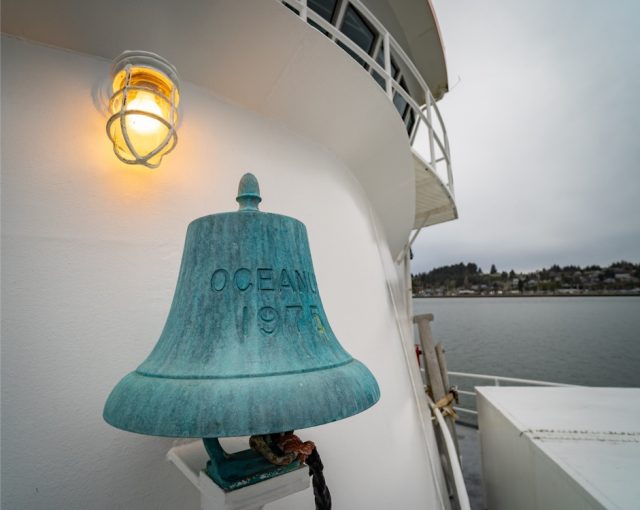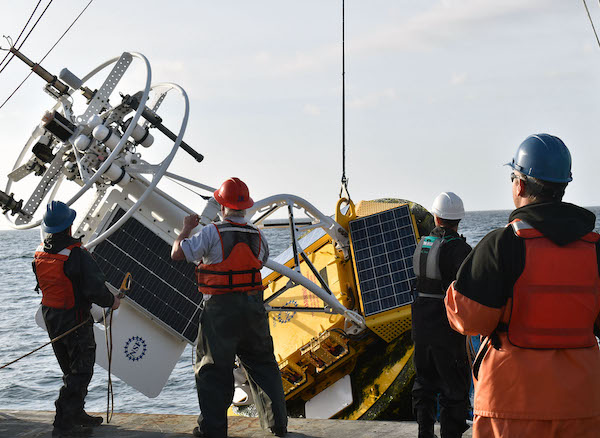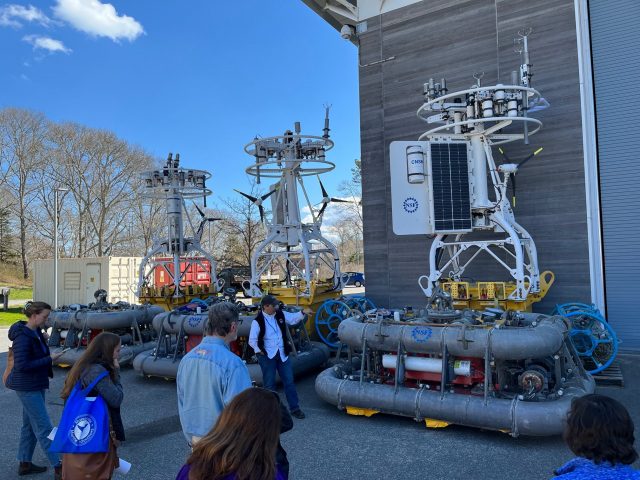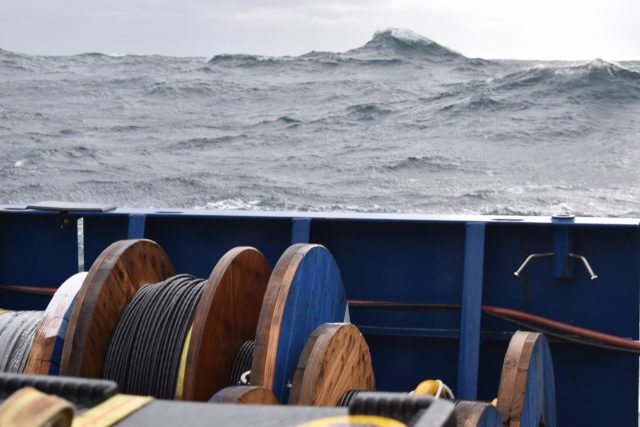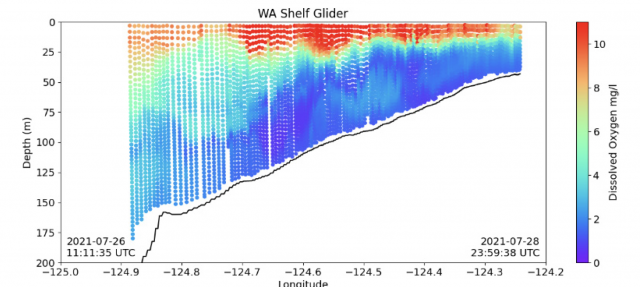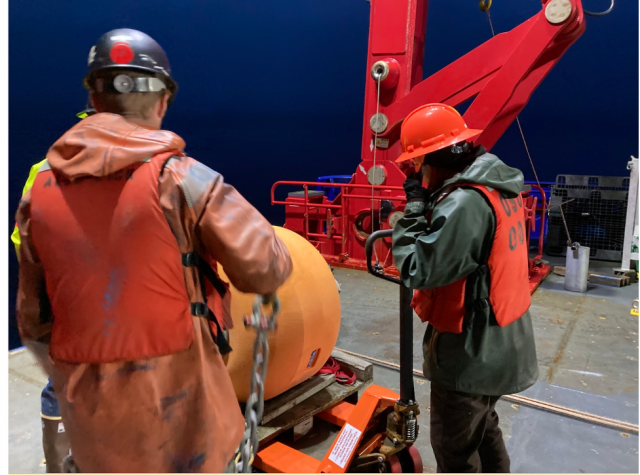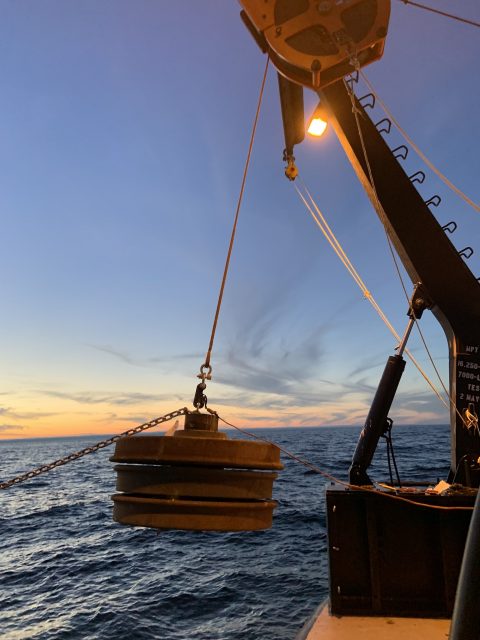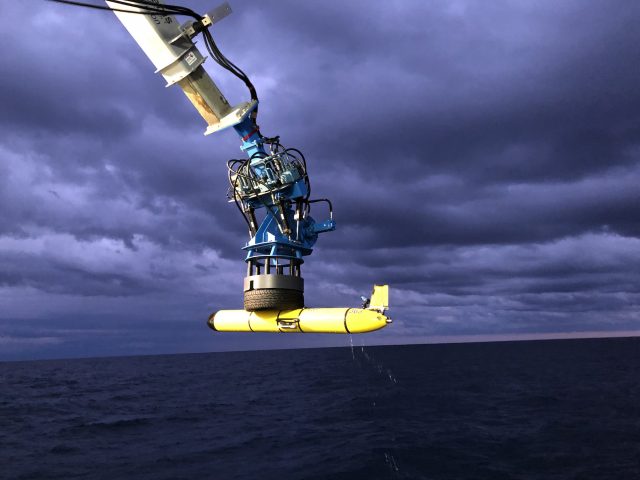News
Striped Bass Link OOI Pioneer Array Locations
A recent article in the Martha’s Vineyard Gazette tells a fascinating tale of how fish like striped bass respond to changes in ocean conditions. The striped bass story also provides links between the current OOI Pioneer Array location on the New England Shelf (NES) and the new location in the southern Mid-Atlantic Bight (MAB).
The Northwest Atlantic has been warming due to both atmospheric and oceanographic influences (e.g., Chen et al., 2014; Gawarkiewicz et al., 2019) and the impacts can bee seen in the distribution of marine species like stripers. The stripers are typically found on the New England Shelf in the spring, with bass fishing tournaments a long-held tradition for islands like Martha’s Vineyard, Nantucket, and Cuttyhunk. But conditions are changing, and as the waters warm, the stripers appear to be moving further north. Data from the NES Pioneer Array are helping researchers and fishers understand the changes.
[media-caption path="/wp-content/uploads/2022/05/Striped-Bass-migration-map.jpg" link="#"]Striped bass spring migration route. Credit: Martha’s Vineyard Gazette and Dana Gaines Martha’s Vineyard Magazine.[/media-caption]
Stripers spawn in brackish water and spend their first few years in estuarine waters like those of the Chesapeake Bay. These waters are changing too, with earlier springs modifying spawning behavior. Understanding how environmental conditions impact the life cycle of stripers from estuary to open ocean requires knowledge of the atmosphere, continental shelf waters, and the Gulf Stream. Finally, it is necessary to investigate interactions that exchange properties between estuaries, shelf and slope sea – which will be the focus of the MAB Pioneer Array currently being planned for implementation in 2024.
References
Chen, K., G. G. Gawarkiewicz, S. J. Lentz, and J. M. Bane (2014), Diagnosing the warming of the Northeastern U.S. Coastal Ocean in 2012: A linkage between the atmospheric jet stream variability and ocean response, J. Geophys. Res. Oceans, 119, doi:10.1002/2013JC009393.
Gawarkiewicz G, Chen K, Forsyth J, Bahr F, Mercer AM, Ellertson A, Fratantoni P, Seim H, Haines S and Han L (2019), Characteristics of an Advective Marine Heatwave in the Middle Atlantic Bight in Early 2017. Front. Mar. Sci. 6:712. doi: 10.3389/fmars.2019.00712.
Schneider, P. (2022), Climate Change Clue: Follow the Stripers. Vineyard Gazette, 12 May 2022.
Read MoreR/V Oceanus Decommissioned and Celebrated
The R/V Oceanus was decommissioned last year, but its 45 years of service to the oceanographic community were celebrated at Oregon State University (OSU) at an event Friday May 6, 2022. The Coastal Endurance Array team used the Oceanus for many recovery and deployment expeditions before her retirement in 2021.
[media-caption path="/wp-content/uploads/2022/05/Picture1-copy.jpg" link="#"]The Oceanus was originally built in 1975 and began its work as a research vessel in 1976. Photo: OSU.[/media-caption]
[media-caption path="/wp-content/uploads/2022/05/graphics-OOI_AST2-DSC_5970.jpg" link="#"]R/V Oceanus departing WHOI on the deployment leg of OOI At-Sea Test 2 (AST-2) on September 22, 2011. Photo: Ken Kostel ©WHOI.[/media-caption]
Prior to its tenure at OSU, the Oceanus was in service at the Woods Hole Oceanographic Institution (WHOI) from 1976-2012. WHOI retired the ship and it was transferred to OSU in 2012. While at WHOI, the ship was used in early test deployments of equipment being evaluated for use in OOI arrays.
“The R/V Oceanus and its sister ship R/V Wecoma remain my favorite research vessels for air-sea interaction research due to their moderate size, uncluttered bows, and streamlined shapes,” said Jim Edson, Principal Investigator of the Ocean Observatories Initiative (OOI). “Research cruises on these vessels led to the development of the direct covariance systems we are using on the OOI surface moorings today.”
The Oceanus will be replaced with a new modern research vessel, the R/V Taani, which is expected to be delivered next year.
The Oceanus’ service in the Pacific is celebrated in this video produced by OSU:
[embed]https://vimeo.com/709661216[/embed]Video remembrance of Oceanus:
[embed]https://www.youtube.com/watch?v=YC2eHJa8Gbs[/embed]Video of departure:
[embed]https://www.youtube.com/watch?v=qRV1IG3rs1o[/embed]Read More
Successful Last Deployment of Pioneer Array on NE Shelf
The Pioneer 18 Array team and crew of the R/V Neil Armstrong pulled into the dock at Woods Hole, MA, on April 27, a day earlier than expected, having completed all objectives of the expedition. Their mission included the last deployment of the Pioneer Array at its current location on the New England Shelf. The Pioneer Array components now in the water will be recovered in November 2022 and redeployed in the Southern Mid-Atlantic Bight in the Spring of 2024.
The expedition consisted of two legs. On leg #1, three Coastal Surface Moorings and multiple gliders were recovered and deployed and autonomous vehicle missions were completed. On leg #2, the team deployed five Coastal Profiler Moorings. Three Coastal Surface Moorings and seven Coastal Profiler Moorings were recovered, two of which could not be recovered during an earlier expedition because of weather conditions. The recovered equipment will be taken apart, refurbished, and in some cases, reconfigured for deployment at the new location.
Weather conditions allowed for multiple deployments of a remotely operated vehicle, to help assess the condition and assist in the recovery of mooring components that could not be recovered by standard techniques (using an acoustically-triggered release). The team also conducted additional activities that ranged from water sampling adjacent to the moorings to cross-shelf CTD (conductivity, temperature, and depth) surveys in the vicinity of the moored array, and surveys using shipboard sensors. A variety of ancillary activities, accommodating eight participants from five different institutions, were also facilitated during the cruise.
Al Plueddemann, Principal Investigator of the Coastal and Global Scale Nodes (CGSN) and Chief Scientist of Pioneer 18 said, “The successful completion of this expedition again demonstrates the capabilities and experience of the CGSN team and the R/V Armstrong, and bodes well for successful operation of the Pioneer Array in its new location in the Southern Mid-Atlantic Bight.”
[media-caption path="/wp-content/uploads/2022/05/last_NES_CPM_PMUI-17-copy.jpg" link="#"]The Coastal Profiler Mooring shown here, PMUI-17, will be the last Pioneer mooring deployed on the New England Shelf. After providing data through the summer and early fall, the current array will be recovered in November of 2022 and relocated to the Southern Mid-Atlantic Bight in 2024. Credit: Jess Kozik©WHOI.[/media-caption]
The Pioneer Array was originally commissioned in 2016 as a re-locatable coastal array suitable for moderate to high wind, wave and current regimes on the continental shelf and upper slope. The new location in the Southern Mid-Atlantic Bight was decided upon after a series of workshops in 2021, co-sponsored by the National Science Foundation and the Ocean Observatories Initiative Facility Board, to gain community input on a new location that would best address pressing science questions.
Plueddemann added, “The Pioneer Array has collected a remarkable data set from the New England Shelf, which scientists will continue to use to understand frontal dynamics and related ecosystem impacts in this important and dynamic region.”
[media-caption path="/wp-content/uploads/2022/05/heads_up-copy.jpg" link="#"]When the large Coastal Surface Mooring buoys are recovered everyone pays close attention. The buoy tower spins when the hull is picked out of the water, and the deck team needs to be ready with a snap hook to clip into the circular rails on the tower top and arrest the motion. Credit: Andrew Reed ©WHOI.[/media-caption]
As the Pioneer 18 team headed home, another CGSN expedition is about to hit the water. A team of scientists and engineers is already traveling to Seward, Alaska to mobilize for another OOI expedition. On May 12, they will be aboard the R/V Sikuliaq for a 19-day expedition to the Global Station Papa Array, in the Gulf of Alaska, about 620 nautical miles offshore. This team will deploy five moorings — three for OOI and one each for the National Oceanic and Atmospheric Administration and the University of Washington. Once on site, the team will first deploy the moorings onboard, then recover those that have been in the water for a year. Upon completion, the ship will transit to the demobilization port of Seattle, Washington. Bookmark this site, and follow along on their progress.
Read MoreWHOI hosts MME Annual Meeting
The Massachusetts Marine Educators Association (MME) 46th Annual Meeting was held at Woods Hole Oceanographic Institution (WHOI) on Saturday April 30th. The event, sponsored by WHOI and Woods Hole Sea Grant, provided an opportunity for educators to get together in person, tour WHOI’s facilities, and learn about how ocean and coastal data can be used in the classroom.
WHOI and Ocean Observatories Initiative (OOI) Engineer Sheri White gave one of the keynote addresses: “The Ocean Observatories Initiative:Collecting Long-Term Coastal and Global Time Series Data.” She followed this with a tour to a group of about 15 people of OOI’s lab and equipment testing and holding area at LOSOS and of some recovered Pioneer Array gear.
[media-caption path="/wp-content/uploads/2022/05/IMG_0498-rotated.jpg" link="#"]WHOI Engineer Sheri White showed participants recovered Pioneer Array gear. Photo: Stace Beaulieu©WHOI.[/media-caption]
WHOI Researcher Stace Beaulieu presented a workshop entitled “Wild Ocean Data: Easily Within Reach.” Her presentation, a tutorial on how to use OOI’s Data Explorer, is available online for those who missed it at https://tinyurl.com/WildOceanData.
[media-caption path="/wp-content/uploads/2022/05/IMG_0495-copy-2.jpg" link="#"]WHOI Researcher Stace Beaulieu showed how to use Data Explorer in the classroom. Photo: Annette Brickley.[/media-caption]
Rounding out the day was a presentation by Education Specialist by Annette Brickley, who presented “Is it Data? or Is it Cake?” She talked about the NES-LTER Data Jam and what students can do with NES-LTER and OOI Data.
[media-caption path="/wp-content/uploads/2022/05/IMG_0997-2-scaled.jpg" link="#"]Education Specialist Annette Brickley presented: Is it Data? Or is it cake? Photo: Stace Beaulieu ©WHOI.[/media-caption]
Read MoreRemotely Fixing and Preventing Mooring Issues
Alex Franks’s job is a big one. He is charged with fixing various issues that occur on OOI moorings, while they are hundreds and sometimes even thousands of miles away in the ocean. As an Engineer II at Woods Hole Oceanographic Institution (WHOI), Franks is intimately familiar with the mooring system controller software, which allows him to troubleshoot and fix instrumentation problems on OOI moorings, regardless of their location.
Franks has been working with electronics for over a decade and solving OOI mooring-related challenges since 2015. Many examples exist of his innovative solutions. In 2020, for example, the satellite Internet service that was being used to send data from OOI moorings to WHOI servers was no longer a viable solution. The WHOI team faced the task of either finding a replacement system, or working with the then-current system. One easily implementable solution was to move to transmitting data through OOI’s Iridium radio antennas full time. There were downsides to this solution, however. It would allow no margin of error, would consume more power, and still not be able to send data from all the instruments.
Franks figured out a better solution that would both keep costs manageable and continue to meet timely data transmission goals by modifying the Iridium file transfer portion of the mooring software to accommodate a new data transfer scheme. The new scheme used a feature of the computer program rsync, a fast and versatile file copying tool, called “diff”. Instead of using rsync to communicate with shore servers and determine the “delta” or change between the new instrument data on the mooring and the instrument data files on the WHOI server, he used one of the mooring’s onboard computers as an intermediary server to generate “diff” files against (delineating old from new data). These files were then generated and stored, and sent over the Iridium connection. Using this new configuration, Franks succeeded in sending the entire dataset of all instruments on the mooring, except one that was sent at a reduced sample rate. While transmission times can vary with weather conditions, this newly configured system sends data to the server every 20 minutes every other hour, reducing transmission times from 1440 minutes per/day to about 240 minutes per day.
[media-caption path="/wp-content/uploads/2022/04/DSC_0639-copy.jpg" link="#"]Waves in the North Atlantic can get pretty large, which makes it hard to conduct research at sea, especially in winter. The waves and wind in the Irminger Sea also create challenges for ocean observing equipment in the water there year-round. Credit: ©WHOI.[/media-caption]
Franks also found ways to remotely manage mooring issues caused by weather and sea state by modifying software that controls wind turbines. Wind turbines play a critical role on OOI moorings, providing power to recharge the main system batteries. At the Irminger Sea Array, where the sun is absent for months at a time (the moorings also utilize solar panels), these wind turbines are critical. Prior to Franks’ software fix, human input was required to disable the turbines to prevent them from spinning while wave heights were too great. Franks modified the software used to control the spinning of the turbines to read environmental data from the buoy itself and make automated decisions in real-time that previously had to be done manually. The system now changes its configuration based on a variety of sensor inputs, which make for more immediate decisions to ensure the continued safe operations of the turbines. The software modifications not only help mitigate heavy sea damage to the turbines but saves power, as well. The software detects when the air temperature is above freezing and turns off the precipitation sensor heaters, conserving energy when possible. The software also has fail-safes in place for high or low voltage and to determine hydrogen concentration levels inside the electronics. An illustration of this software configuration is provided below.
[media-caption path="/wp-content/uploads/2022/04/Mooring-system-software-upgrade.png" link="#"] This new software configuration detects when the air temperature is above freezing and turns off the precipitation sensor heaters, and has fail-safes in place for high or low voltage and for hydrogen concentration levels inside the electronics .Credit: ©WHOI.[/media-caption]
Franks has also developed software improvements to the power system controller inside the OOI surface moorings. His work ran the gamut from disabling operational bugs in the system to reducing power consumption to fixing software errors to increase reliability. During a year-long deployment in the Irminger Sea, part of the power system controller board failed. Franks installed a software patch remotely that was able to limit the level of charge coming from wind turbines and wrote a fail-safe feature for the system to disconnect all charging sources if the voltage approached dangerous levels.
The challenges are what keeps Franks enthusiastic about his job, “I just love trying to figure out a solution and it’s particularly rewarding to be able to remotely resolve issues with equipment deployed in the open ocean.”
Read More
Efforts to Standardize Data Continue
The OOI Data Teams have recently made great strides in ongoing efforts to standardize data, making it easier for users to understand what OOI data and metadata are available. Efforts have focused on improving labeling, descriptions, and correcting units to ensure consistency. A major improvement underway is matching variable naming conventions with those governed by Climate and Forecast (CF) metadata standards.
The first round of changes is expected to be completed by the end of June 2022. Once these changes are implemented, existing scripts used to download and process OOI data files could be impacted depending on how the code was written. The Data Teams will publish a list of affected streams and recommended code updates prior to the release of these changes, to highlight the improvements and to allow for processing script modifications.
Read MoreIn Spite of Weather, Endurance 16 Delivers
Weather did not deter the Endurance 16 cruise to recover and deploy ocean observing equipment to ensure the continuance of data to shore for the next six months. When heavy weather closed in at the end of the second leg, the science party and crew aboard the R/V Sikuliaq met the challenge, accelerated their schedule, and arrived back in Newport on April 2, several days early.
“In spite of the less-than-ideal weather conditions, we successfully accomplished all activities with the exception of the Oregon Coastal Surface Profiler (CSPP) deployments and the Oregon offshore anchor recovery,” said Ed Dever, Chief Scientist for Endurance 16 and Principal Investigator of the Coastal Endurance Array team at Oregon State University. “When the weather cooperates, we will use a smaller vessel to deploy the remaining CSPP’s. The anchor recovery will be done during Endurance 17.”
He added, “Early spring weather in the Northeast Pacific can be unpredictable and sometimes pretty nasty for shipboard operations. We carefully monitored the weather conditions and adjusted our recovery and deployment schedule accordingly to maximize work that could be accomplished during safe weather conditions.”
[media-caption path="https://oceanobservatories.org/wp-content/uploads/2022/04/Endurance-1.png" link="#"]Working to the weather. Spring in the North Pacific can bring pretty high winds and seas. When the Endurance 16 team had good weather, they pressed on through long days. Here Alex Wick and Kristin Politano get a subsurface float into position on the R/V Sikuliaq during an evening mooring deployment on the OOI Spring Endurance cruise. Credit: Ed Dever, OSU[/media-caption]
In spite of the abbreviated time at sea, in addition to the mooring deployments, the Endurance 16 team also successfully deployed four gliders and recovered another. And, during the second leg of the cruise, a scientific party of five that had joined the expedition succeeded in collecting and recovering sediment trap samples for an ongoing experiment led by Dr. Jennifer Fehrenbacher of Oregon State University.
The sediment traps had been collecting material in place for the past six months and were recovered during the Endurance 16 team’s recovery and deployment work. Once the traps were back onboard, the collecting cups were taken off, emptied, replaced, and the traps redeployed for another six-month period. The researchers packaged the collected materials for analysis at OSU and her collaborators at the University of South Carolina.
The team also analyzed live specimens from night-time plankton tows, which took advantage of the quiet night-time hours when the Endurance team was unable to safely move large, bulky, equipment in the dark.
Added Dever, “Success at sea is about teamwork, and I really appreciate the science party and the captain and crew of the R/V Sikuliaq. Everyone was flexible and willing to work long, arduous hours to get the job done.”
[media-caption path="https://oceanobservatories.org/wp-content/uploads/2022/04/Endurance-in-port.png" link="#"]At the end of an expedition everyone’s eager to get home. Here the R/V Sikuliaq approached NOAA’s pier in Newport, OR, but there was one more chore to do – get that recovered equipment off the deck. The motivated crew and science party cleared the deck within 2 and half hours of docking! Photo: Ed Dever, OSU[/media-caption]
Read More
Ride Along with Pioneer 18
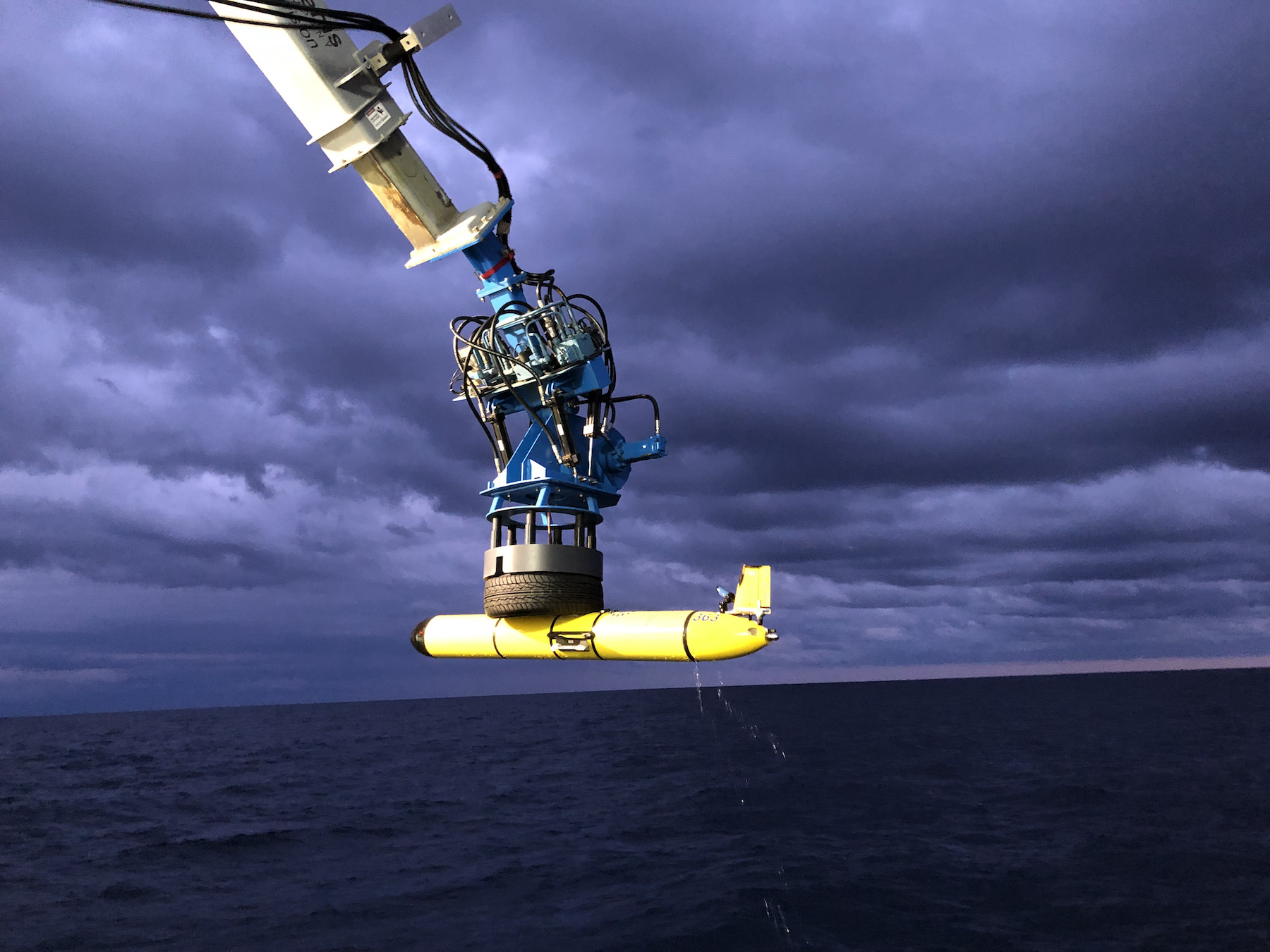 Here’s an opportunity to travel along with the team of sixteen scientists and engineers as they conduct a bi-annual recovery and deployment of ocean observing equipment at the Coastal Pioneer Array. This is the 18th “turn” of the equipment since the observatory was put in place in 2015. The data collected has advanced understanding of the shelf/slope dynamics and impacts on ecosystems. Bookmark this page to follow along on the expedition, which runs through the end of April.
Here’s an opportunity to travel along with the team of sixteen scientists and engineers as they conduct a bi-annual recovery and deployment of ocean observing equipment at the Coastal Pioneer Array. This is the 18th “turn” of the equipment since the observatory was put in place in 2015. The data collected has advanced understanding of the shelf/slope dynamics and impacts on ecosystems. Bookmark this page to follow along on the expedition, which runs through the end of April.
18th Turn of the Pioneer Array in April
Sixteen science party members will be on board the R/V Neil Armstrong during April for each of two legs comprising the eighteenth turn of the Pioneer Array, where moorings are recovered and new ones deployed. This April cruise will be extremely busy, with 32 overall objectives, as well as other ancillary operations. Pioneer 18 is the first cruise since 2020, when COVID-19 protocols were implemented, to support a larger science party to conduct ancillary activities.
The cruise plan calls for deployment of eight moorings and three gliders and recovery of 10 moorings. Autonomous underwater vehicle (AUV) missions will be conducted in the vicinity of the moored array, providing additional ocean observing measurements. CTD casts and water sampling will be done in conjunction with deployment/recovery operations and ship vs. buoy meteorological comparisons will be made at each Coastal Surface Mooring site.
[media-caption path="/wp-content/uploads/2022/03/DSC0507.jpg" link="#"]During Pioneer 18, ten moorings will be recovered. Once close to the ship, crew members grab the moorings with a hook, and direct them to the stern of the ship to be brought onboard. Credit: Darlene Trew Crist ©WHOI.[/media-caption]
“We are pleased to be approaching full capability for Pioneer 18 after multiple cruises with COVID-related restrictions,” said Al Plueddemann, chief scientist for Pioneer 18 and lead for the Ocean Observatories Initiative Coastal and Global Scale Node of which the Pioneer Array is part. “There is a lot to accomplish over our 21 days at sea, and having the opportunity again to bring collaborating scientists onboard will make full use of the ship and our time at sea.”
On Leg 1, Scientists Mei Sato of Woods Hole Oceanographic Institution (WHOI) will join Pioneer 18 to conduct zooplankton sonar testing, Peter Duley of the National Oceanic and Atmospheric Administration will conduct Marine Mammal Observations, and a student from the University of Rhode Island will oversee a glider deployment. Additionally, unattended underway sampling will be conducted in support of the Northeast U.S. Shelf (NES) Long-Term Ecological Research (LTER) project on Leg 1. On Leg 2, NES-LTER efforts will increase, with four participants (two from WHOI and two from the University of Rhode Island) onboard to conduct activities that include CTD and ring net casts and incubations, as well as continuing unattended underway sampling.
[media-caption path="/wp-content/uploads/2022/03/IMG_6146.jpeg" link="#"]Plans are to deploy three gliders that will collect data in the water column between the Pioneer moorings for the next sixth months. Credit: Darlene Trew Crist ©WHOI.[/media-caption]
Weather conditions and time constraints during the Pioneer 17 cruise precluded complete recovery of the Offshore and Upstream Offshore Profiler Moorings. Additional objectives for Pioneer 18, to be conducted if time and conditions permit, include completing the recovery of these two moorings, as well as several anchor recoveries using a remotely operated vehicle (ROV), glider tests, and surveys in the vicinity of the Pioneer moored array using shipboard systems (CTD, ADCP, EK-80).
“We have a very ambitious agenda for Pioneer-18, but our team is experienced and well-equipped to complete this large list of tasks ,” added Plueddemann. “We just need a good weather window to get the job done.”
Pioneer 18 team members will be sharing their progress during the month of April. Bookmark this page and follow along.
Read More
Uncovering Changing Life in the Water Column
Oregon State University Assistant Professor Jennifer Fehrenbacher needed a ship to carry out her National Science Foundation-funded research investigating the lives of foraminifera (single-celled organisms about the size of a grain of sand and smaller) in the northern Pacific. Her work, in collaboration with Dr. Claudia Benitez-Nelson at the University of South Carolina (UofSC), involves deploying bottom-moored sediment traps and collecting plankton tows while at sea, giving researchers the opportunity to explore foraminifera that live in lighted surface waters, and how these communities have changed over time in response to the surrounding ecosystem.
Fehrenbacher found her ship. She will be joining forces with the Endurance Array Team aboard the R/V Sikuliaq during its bi-yearly expedition to recover and deploy ocean observing equipment at its array in the northeast pacific off the coast of Oregon. Fehrenbacher and her team of four researchers will join the Endurance Array 16 team in early April for the second of its two-leg expedition. This will be a continuation of her research project that began in September 2021.
Last September, Fehrenbacher’s team put in place two tandem sediment traps that are located close to the OOI Slope base node. One was deployed at about 600 meters water depth, the other slightly above the sea floor. The last sediment trap study in this region was conducted around 30 years ago, and the foraminiferal species have likely changed since then, as have ocean conditions.
[media-caption path="/wp-content/uploads/2022/03/IMG_5185-copy.jpg" link="#"]Fehrenbacher’s team will be retrieving two tandem sediment traps that are located close to the OOI Regional Cabled Array slope base node. Credit: Jennifer Fehrenbacher, OSU.[/media-caption]
The sediment traps have been collecting material in place for the past six months and will be recovered along with the Endurance 16 team’s recovery and deployment work. Once the traps are back onboard, the collecting cups will be taken off, emptied, replaced, and the traps redeployed for another six-month period. The researchers will package the collected materials for analysis at OSU and UofSC.
The team also will be examining live specimens from night-time plankton tows, taking advantage of quiet night-time hours to conduct the plankton tows when the Endurance team is unable to work safely moving large, bulky, and unwieldy equipment in and out of the ocean. “This arrangement is a win-win for everyone,” said Endurance Array Chief Scientist Ed Dever. “It maximizes the use of ship time, while helping to provide data to answer some questions about how ocean conditions are changing.”
Fehrenbacher’s team will be conducting a series of discrete new tows from the surface to about 500 meters. “While I don’t anticipate a ton of critters in the really deep water, net tows haven’t been done extensively in these waters at these depths. The last one was 30 years ago by oceanographer Alan Mix and his graduate student Joseph Ortiz, so this new work will give us insight into how life in the water column may have changed over time, “ said Fehrenbacher.
Fehrenbacher’s team will be conducting experiments with live foraminifera in a portable travel lab they will bring onboard. A number of different experiments are planned:
PhD candidate Kelsey Lane will be collecting foraminifera (shortened version “forams”) to study their genetics and their microbial communities, other species living with forams.
Graduate student Grace Meyer will be striving to measure carbon and oxygen isotopes in individual forams. She will be collecting empty shells from both the water column and sediment trap material and compare what is found in both, providing information about water column processes that could alter shells’ composition.
Postdoctoral researcher Brittany Hupp will be collecting both live forams and empty shells to study the chemistry of different types of forams, looking at their isotopes and trace metals content.
Researcher Eric Tappa, a sediment trap expert from the UofSC, will be deploying and recovering the sediment trap equipment. Tappa has been working with sediment trap moorings for decades and have proven critical in providing longer time-series records of processes occurring in overlying waters.
As lead scientist Fehrenbacher will be participating in these onboard experiments. She also will be growing forams under controlled conditions and watching them to learn how temperature modulates their shells or their behaviors during the day-night cycle, and will continue her work with recovered forams once she returns to her home lab. There she will be measuring the trace element concentrations in foram shells so results can help inform the Paleo record. . She explained, “Foram shells are used basically as proxies for environmental conditions. So when we measure trace elements in their shells, this gives us information about the pH, temperature, nutrient content, and even the salinity of the ocean in the past.” The onboard experiments help scientists under how forams incorporate these elements into their shells when they are alive, which they can use in assessing past records.
[media-caption path="/wp-content/uploads/2022/03/IMG_5196-copy.jpg" link="#"]An anchor weighing ~2500 pounds is deployed to keep a sediment trap in place for six months until it is recovered with a treasure trove of marine life and particulates for investigation. Credit: Jennifer Fehrenbacher, OSU.[/media-caption]
Challenges of studying small living things
Studying single-celled organisms is difficult on dry land, but is compounded by a moving ship in rolling seas. Fehrenbacher’s team will be taking onboard multiple microscopes, including an inverted microscope to see their subjects, water circulators to keep them at constant conditions while they are alive, and a pH meter. High-powered microscopes are critical for the work because forams range in size from smaller than a grain of sand—about 100 microns— to up to about a millimeter.
“We look at forams in a petri dish under the microscope,” explained Fehrenbacher. “This is challenging as the ship moves back and forth so does the water in the petri dish so you’re looking back and forth as the ship moves.” The researchers have come up with the solution of holding the petri dish at an angle so the water and foram stay in one place and helps prevent researchers’ sea sickness.
Fehrenbacher predicts that the amount of material collected on the Endurance Array 16 cruise will keep she and her graduate students busy for at least the next two years and beyond. She added, “There’s really just nothing quite like the type of information you can get from sediment trap studies. While going out to sea for two weeks a year and doing plankton tows are helpful, we only get information about what’s in the water column at the exact moment of collection. But sediment traps provide months’ worth of data at really high resolution that we can compare with other OOI data and get a detailed picture of ocean conditions and how those conditions affect marine life.
Read More


